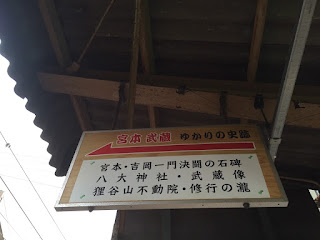#4 Hachidai Shrine (八大神社)
This shrine is associated with Musashi MIYMOTO who was a master of the sword during the early Edo period in Japan.
The nearest station to the Hachidai Shrine is Ichijoji Station on the Eizan line of Keihan Electri Railway. It's the third station from Demachiyanagi Station on the main line of the railway and unmanned.
Ichijoji Station
Continue in the direction of the arrow.
There is a map.
Keep walking along the road straightly.
There are a few cafes and restrants.
There is a secondhand book store.
It may be a good idea to buy some Japanese books in order to feel real Japan and give them to your friends as souvenirs.
When you see the convinience store named circle K, there is a signboard, and across the street in the dirrection of the arrow.
Go up the hill. There is a cafe on you right.
Decchi Yokan (でっち羊かん) is one of the local specialities around Ichijoji. It is inexpensive ns which contain less azuki beans and sugar compared with ordinaly type yokan in those days. Decchi means an apprentice, and it is cheap enough for them to buy as a souvenir when they go back home for a visit.
Decchi Yokan.
A signbard again. Keep straigt.
There is a stand you can buy Decchi Yokan or other wagashi (Japanese sweets and snacks).
Finally, you arrive on the Hachidai shrine.
The Hachidai shrine is the place noted in connection with Musashi MIYAOTO. He is famous for his swordmaship and one of the greatest warriors in Japanese history. Musashi challenged the Yoshioka clan to a a duel at the Ichijo Temple Sagarimatsu (一乗寺下がり松) in 1604.
He knew the duel wouldn't be one-to-one, but had no way to know how many enemies were on the watch for the duel. As legend has it, Musashi fought alone against 100.
When he passed nearby the Hacidai Shrine before the duel, and an idea flashed into his mind: Turn to the god for help. But on the second thought, he became embarassed because he realized that he tried to rely on divine protection. He went off just after vowing sligtly, with the belief that " Respect the god, but not pray for help."
Then, Musashi penetrated toward the battlefield.
There was a weeping pine tree called Sagarimatsu (下がり松) there. So the duel is called Ichijoji Sagarimatsu no Kettou (一乗寺下がり松の決闘).
The Hachidai Shrin keep real SAGARIMATSU at that time in the precincts.
A bronze statue of Musashi MIYAMOTO.
It is said that he was 21when the duel broke out.
A main shrine.
The Hachidai Shrine is worshipped as a shrine for conjugal harmony because it is known that enshrined dieties, according to the Japanese myth, Susanou-no-mikoto and Inadahime-no-mikoto married for love. ROMANTIC!
Susanou-no-mikoto and Inadahime-no-mikoto
Quating from the website of the Hachidai Shrine:
This is an ideal location for renewing your vow♡
----------------------------------------------------------------------------------------------------------------
Adress: 1 Ichijo-ji Matsubara-cho, Sakyo-ku, Kyoto
Access: 15 minutes walk from Ichijoji Staion on Eizan line of Keihan Electric Railway
Open hours: all day (the shrine office: AM9:00〜PM5:00)
----------------------------------------------------------------------------------------------------------------
If you are interested in Japanese-style vow renewal at the shrine, visit our website and submit the application form. http://wrappedinjapan.jp




















0 件のコメント:
コメントを投稿